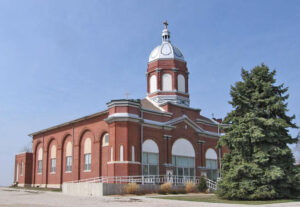Emerald, Kansas, is an extinct town in northwestern Anderson County, but it still has the beautiful St. Patrick’s Catholic Church.
Located on Iantha Creek on the Anderson-Franklin border, the community was first settled by immigrants from old Ireland or the Emerald Isle in 1856. Some of these early Catholic settlers included Thomas Collins, Henry Collins, David and William Fitzgerald, Edward Reddington, Jerry Sullivan, Michael Glennon, Hugh McEvoy, Sr., Terrance Magrath, and his sons Daniel Doolin, Patrick Campbell, and James McLindon and his son Patrick.
A Belgian missionary named Father Scott presided over the first Mass, held in Edward Reddington’s home, in May 1859. Shortly afterward, construction began on a log cabin church. The church was located on prominent hilltop acreage donated by Henry Collins. Logs were hauled from as far away as Garnett.
Once completed, Father Schnacht, a Carmelite, would regularly ride from Scipio to Emerald on horseback to say Mass.
The Homestead Act of 1862 brought additional settlers to the territory. Shortly after the Civil War, the log cabin church was no longer adequate for the growing community, and a new 55 x 35-foot stone church was constructed. Native stone was quarried, but sand for the mortar was not available. Consequently, parishioners manually crushed rock into sand. John Hoffman, a Burlington stone mason, did the masonry work, and the church was dedicated on August 15, 1870.
In the meantime, a post office was established on June 15, 1869.
In 1878, it had a Catholic Church and a graded school, and its mail was delivered four times per week to Terence Magrath, the postmaster. Williamsburg was the most convenient shipping point on the Kansas City, Burlington & Santa Fe Railroad.
During the 1870s and 1880s, large numbers of immigrants flowed into Kansas. Soon, Emerald became an Irish-German community. By 1895, more than 75 families attended church. However, the post office closed that year on September 14.
Forty years after the first Mass, a magnificent 55 x 100-foot Roman-style church was dedicated. The structure was made of brick, and the foundation was made of granite rock from Texas. The majestic dome was visible from many miles away. St. Patrick’s became known as the “Cathedral of the Plains.”
By the 1930s, America’s economy turned from agriculture to industry, and by 1936, Emerald had dwindled to 48 families. Tragedy struck on September 29, 1939, when the church was hit by lightning and caught on fire. The small parish faced a challenging situation, causing $50,000 in damages and only $10,000 in insurance. However, the community was determined, and the church was restored to its present state by November 1940. At this time, the bell was removed from the tower but was preserved and stands at the entrance to the cemetery,
In 1953, under the guidance of Father Jack Herrington, the church was renovated, including improvements to plumbing and heating and new plate glass windows and doors. In 1955, construction of the parish basement and kitchen began.
Today, the church still serves a local congregation. The crucifix over the main altar was carved by hand in Rome and took five months to make. The cemetery is located a short distance behind the church.
It is 14 miles from Garnett, the county seat.
©Kathy Alexander/Legends of Kansas, updated October 2024.
Also See:
Sources:
Find a Grave
Historical Directory of Kansas Towns
St. Patrick Church


